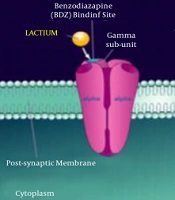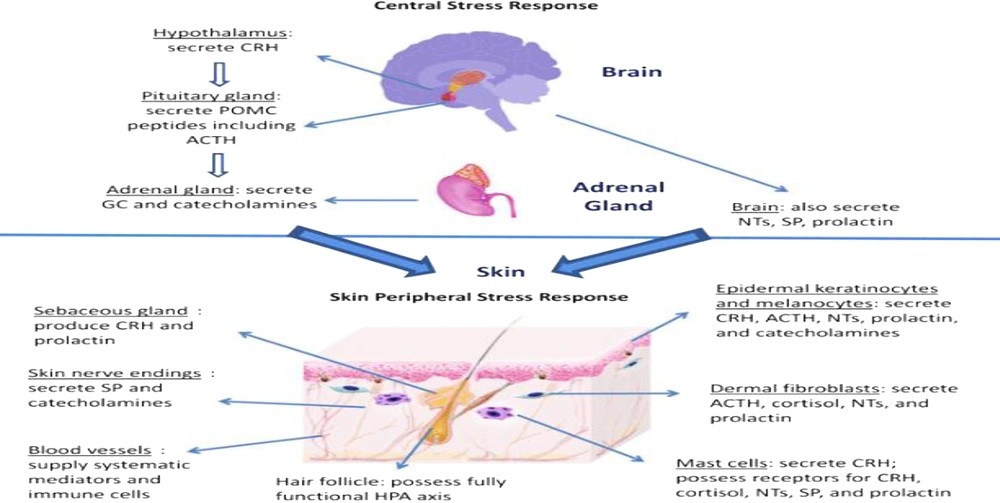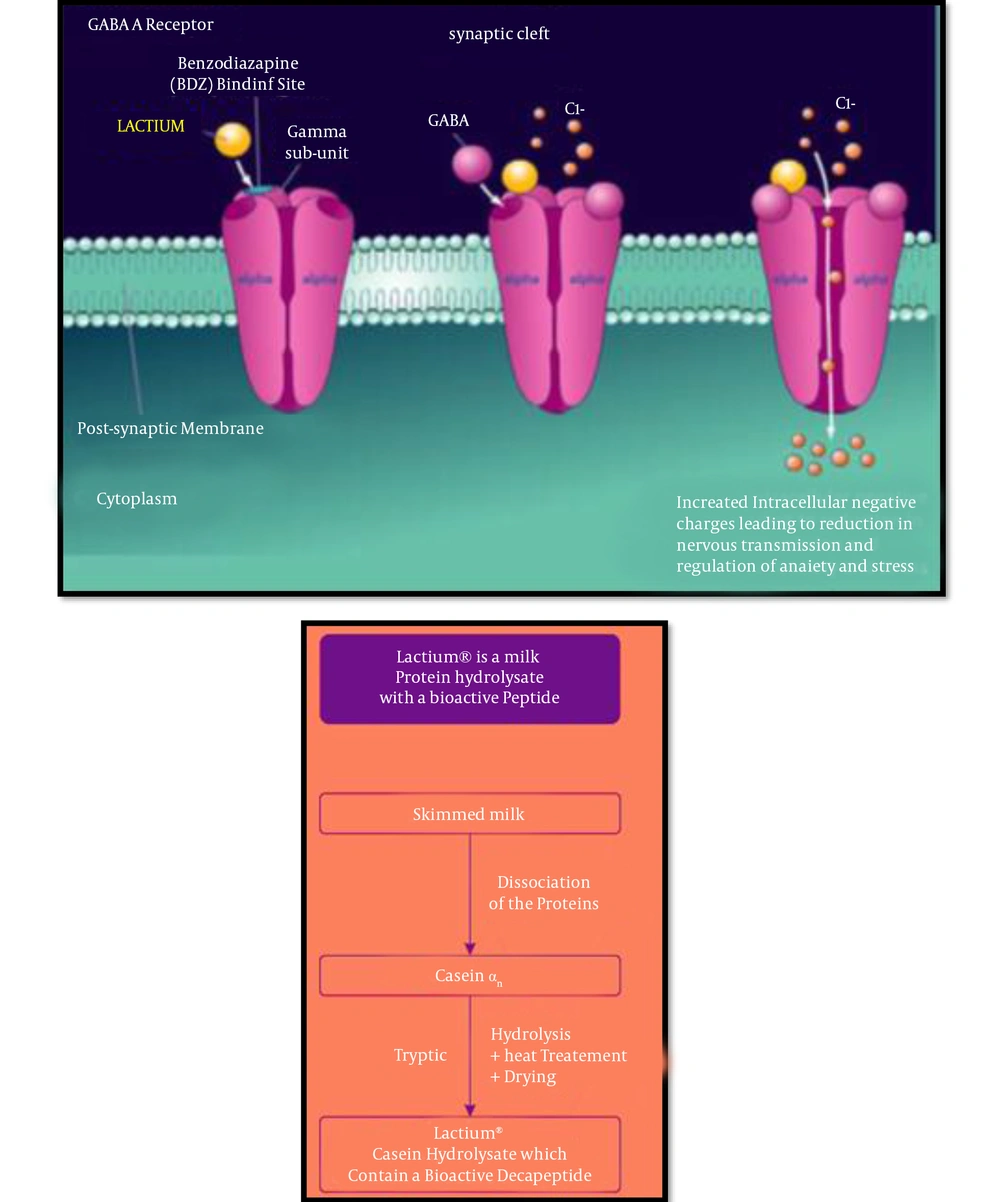Dear editor,
Lactium is a milk protein hydrolysate, which contains a bioactive decapeptide, known as α Casozepine, which binds to GABA Receptors. Gamma-aminobutyric acid (GABA) is the principal inhibitory neurotransmitter in the central nervous system (CNS). Hence, it can be used to alleviate the symptoms of pruritus or pain in psychocutaneous disorders. This article aimed at discussing the use of a novel drug called “Lactium” in dermatological (psychocutaneous) disorders.
Psychocutaneous disorders are dermatological disorders in which the symptoms of the skin disease are affected by the psychological as well as the mental state of the patient. These disorders can often be aggravated by emotional stress and/or anxiety in maximum number of cases (Table 1).
| Diseases | Percentage of Patients, Showing Disease Exacerbation Due to Stress |
|---|---|
| Psoriasis | 54 - 60 |
| Acne | 50 |
| Alopecia areata | 60 |
| Rosacea | 58 |
| Urticaria | 16 |
| Pompholyx | 17 |
| Vitiligo vulgaris | 47 |
Represents the Proportion of Patients Regarding Disease Exacerbation Due to Stress (1)
There are few more skin diseases that are exacerbated by stress e.g., atopic dermatitis, telogen effluvium, lichen planus, psoriasis, herpes simplex infection, hyperhidrosis, etc. There can be a vicious cycle of stress-disease exacerbation; hence the psychological and occupational stress in the given case should be assessed. The underlying mechanisms include over-expression of corticotropin-releasing hormone (CRH), activating inflammatory and immunological processes, and action of neuropeptides (Figure 1) (2).
Schematic diagram, showing peripheral response of skin to stress (3).
Usually, in such conditions, pharmacologic therapy with benzodiazepines (BDZ) and selective serotonin reuptake inhibitors (SSRIs) is used, but these have lots of side effects. In fact, α-s1-Casein hydrolysate (Lactium) is a milk protein hydrolysate, which contains a bioactive decapeptide, called “α Casozepine”, which binds to GABA receptors. Gamma-aminobutyric acid is the principal inhibitory neurotransmitter in the CNS (Figures 2A and B).
The pentameric GABAA receptor consists of five subunits (α1−6, β1−3, γ1−3, δ, ε, θ, and π), and the assembly of different combinations of these subunits leads to the formation of different types of GABAA receptors. Each of these subtypes has a special function and pharmacological property (4). Maximum number of GABAA receptors are composed of two α subunits, two β subunits, and one γ subunit.
Mechanism of action: Lactium binds to the GABAA receptors of the CNS. GABAA receptors, formed by a co-assembly of at least 19 different subunits, have three binding sites ω1, ω2, and ω3 (4-6). Lactium selectively binds to ω2 binding site and results in increased membrane chloride conductance, causing an influx of chloride ions (Cl-) and membrane hyperpolarization (Figures 2A and B). This leads to the reduction in neurotransmission and regulation of anxiety and stress without the sedative effects (5, 6).
Lactium selectively targets alpha-2 receptors that play a role in stress, anxiety, cognition, and emotions. Most of the benzodiazepines do not show any selectivity towards alpha-1 or alpha-2 receptors. Alpha s1-Casein hydrolysate has two flexible tyrosine aromatic rings with structures that are similar to the classical benzodiazepine aromatic rings; thereby, demonstrating anxiolytic effects in addition to the blood pressure control, immune control, and anti-thrombotic effects.
Lactium has been shown to decrease serum cortisol levels, improve sleep quality and efficiency, decrease anxiety and general fatigue and reduce stress-induced symptoms related to digestion, intellectual, emotional, and social problems in several preclinical and clinical studies (7, 8). A complementary to chronic stress efficacy study done at Necker-Enfants Malades Hospital 46 and BIOFORTIS demonstrated the efficacy of Lactium used in higher doses (200 and 300 mg, respectively) in acute stress management and hence can be used in managing certain stress-inducing life events like school exams or special events related to private or professional life (8).
Lactium was found to be useful in alleviating symptoms associated with digestive, cardiovascular, intellectual, emotional, and social disorders for the patients (8). It is non-sedative, non-addictive anxiolytic drug that is helpful in improving disease-associated anxiety by potentiating the effect of GABA by binding to GABAA subtype of receptors, causing an influx of chloride ions, which hyperpolarizes the neurons and decreases the transmission of stress signals. However, there are no studies, so far, regarding its efficacy (9).
Lactium can be an adjuvant ally in the armamentarium of drugs prescribed in various stress-induced conditions like acne, psoriasis, atopic dermatitis, alopecia, urticaria, vitiligo, and many more. It is safe with no side effects or adverse events. It is a non-sedative and does not affect the cognitive ability of the patients. Managing stress and anxiety can result in better outcomes in most dermatological conditions.


